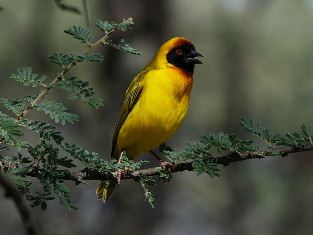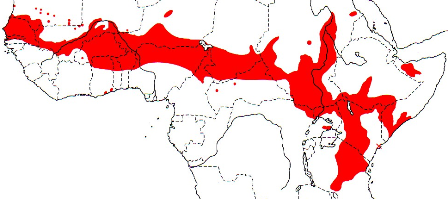Weaver Wednesday [48]: Vitelline Masked Weaver 2013-05-15 (366)
 Weaver Wednesday
Weaver Wednesday

The Vitelline Masked Weaver Ploceus vitellinus is a common weaver from West to East Africa. It is very similar to the Southern Masked Weaver and has been been considered a subspecies of the latter as the two species do not overlap in range. The male Vitelline Masked Weaver in breeding plumage has a black mask, bright yellow underparts and a red eye. The bill and mask are smaller than in other masked weavers and the mask is neatly rounded on the throat. The female and non-breeding male are olive above and yellow below, with a reddish eye.

P. v. uluensis (from Ethiopia south to Tanzania) was recognised until recently but due to considerable individual plumage variation the species is now considered monotypic. It is found from SW Mauritania across the West African savanna belt to Kenya and Tanzania (see map right, based on Birds of Africa). It has been introduced to a bird park near the Yarkon River, Tel Aviv, Israel.
The Vitelline Masked Weaver inhabits dry savanna woodland and scrubland in the sahel belt and similar semi-arid regions. It roosts in Acacia trees with other weaver species, and forms nomadic flocks in the non-breeding season. It feeds on seeds and insects; and it also takes the nectar of Leonotis nepetifolia by biting a flower off at the base, mandibulating it to extract the nectar, and then discarding it. On the ground it moves mainly by hopping and it can move rapidly sideways along a branch.

The Vitelline Masked Weaver is polygynous and colonial, but is not found in large colonies. Typically it occurs in small groups of nests with a single male in attendance. Its nest is oval to pear-shaped, with the entrance below and a high lip inside. It is tightly woven, and has a very short entrance tunnel or none at all. The nest has a ceiling made of grass heads of 2-3 different kinds while the floor is lined with softer grass heads. Nests are suspended from a single central point of attachment; sited 2-5 m above the ground along or near the tip of a pendulous branch; and often far from water. The male removes nearly all the leaves around a nest. In dry country it often nests in trees over a pool in a garden or desert oasis. The nest usually has broad blades wrapped around the nest, giving it a distinctive look. The egg colours vary widely as is the case with Southern Masked Weaver eggs.

A great sequence of photos of a male building a nest may be seen here.
The Vitelline Masked Weaver has 3 PHOWN records, 2 from Tanzania and 1 from Ghana. Many more PHOWN records are needed for this locally common species (see PHOWN summary). Look out for waxbills and finches using old nests and submit PHOWN records for these nests as well. Submit any weaver nest records to PHOWN (PHOtos of Weaver Nests) via the Virtual Museum upload site.
PHOWN summary
Previous Wedn: Golden-backed Weaver
Full weaver species list
| 

 Weaver Watch
Weaver Watch


